Introduction
As of now, markets are overflowed with numerous items and services that are feebly separated. Predominantly, organizations have the ability to duplicate items and services from their rivals. Additionally, numerous items sold in the business sector perform generally comparable tasks. Case in point, both LG Washers, and Brands Mart USA clothes washer give the buyers comparable services. In such manner, product separation does not inform the decision of product or service among the clients in the business sector.
Then again, because of the absence of product separation, the determination of things in the business sector is exceedingly impacted by client administration. Client service involves the nature of a product or a service, solid auspicious service procurement, and sensible costs achievable through value separation (Angel and Sanchez 436). In such manner, companies use client service to separate themselves from their competing organizations in the market so as to make progress.
Background to the study
The client service might be characterized as the procedure of fulfilling the client, with respect to the product or service in the way the client characterizes his or her need and having that service conveyed with viability, empathy, and affectability. The central objective of client service is to deliver opportune answers for the client needs, resolve their protests and issues, and make an alluring interaction environment with items and administrations (Barney 106).
In spite of the fact that the essential goal of client service is to make consumer loyalty, a great client service suggests divergent things to various clients. For example, a universal flight that leaves and lands on time is a fantastic customer service to a bustling tourism official.
Notably, working with a reliable office supply store that maintains a good inventory of products on hand and delivers dependably is an excellent customer service to a pressured executive administrative assistant. Further, competent, and caring advice from the career advisor on the best course of study is the best service for a college student entering a new school. However, in reality, the only perspective that matters is the customer’s concept and perception of good service at the time it is needed and delivered (Burns and Bush 28). The main customer service variables identified in this paper are the role of quality products and services in business success, the role of price differentiation in the business success and the role of reliable timely service provision on business success.
Alteration in the marketing mix is an important element that influences the sensitivity of the consumers. Immediately a customer decides to visit a franchise shop, the environment of the store can have an impression on them. For instance, the elements such as the smell, music, shading, social settings and virtual shopping circumstances are likely to impact the consumers. In the event that the physical environment of the store is encompassed with a great atmosphere, the buyers may have a positive bearing and they will have a tendency to purchase the item from the franchise store.
Furthermore, the primary ideas of the thought of marketing mix could likewise be connected to the circumstance surrounding the customer service. The adjustment of some customary examples exceptional to the economy of a state implies likewise the change of the classifications which involve the given advertising device. In this way, it is evident that under current conditions, such classes as product, price, promotion and place get new significance affected by an incredible number of outside variables. That is the reason; it is additionally basic to consider the thought that the consumer perception could be influenced by the arrangement of variables that advance a specific improvement of the circumstance impossible to miss.
Problem statement
The creation of a superior experience for the customer via delivery of quality products and services is one major step in which retailers can improve their opportunities for developing successful businesses. In the context of internet retailing, service quality should be conceptualized, broadly as the degree to which the consumers’ serves needs have been met (Chaudhuri and Holbrook 82). Notably, over the last two decades, many studies demonstrated the role of product and service quality in shaping customer behaviors and experiences.
Specifically, such studies have shown that the quality of goods and services have a positive impact on a range of customer based success measures such as customer trust, customer intention to buy and customer satisfaction (Chaudhuri and Holbrook 82). In this case, this paper hypothesizes that the quality of products and services has a positive impact on the success of the business.
Research purpose and rationale
This study is fundamental as a result of the way that it fabricates onto the available collection of data regarding the segments that influence the customers to be connected to the business sector. The eventual outcomes of this study are extraordinarily critical to the business proprietors in light of the way that they can use it for sorting out purposes, so they can consider evident destinations to draw in and hold a broad customer base.
Research Objectives
The general objective of this paper was to investigate the role of customer service in business success. This paper intends to achieve some number of goals, which include:
- To evaluate the relationship between customer service and customer response,
- To assess the impact of quality customer service on the overall business success.
Research Question
The above research objectives will be assessed by taking into consideration the following research question.
- What is the role of customer service in the business success?
Research Hypothesis
The paper is based on the following null (H0) and alternate (H1) research hypotheses to achieve the research objective.
- H0: High-quality directly customer service correlates with higher customer response.
- H1: There is no correlation between high-quality customer service and the overall business success.
Literature review
Introduction
This section surveys the speculations both experimental and hypothetical that are firmly connected with comprehension the relationship between the quality of customer service and the success of the business.
Overview of Customer Service
A customer is someone who has bought a product, idea or service from a company, seller or supplier (Chaudhuri and Holbrook 82). However, from the view of customer satisfaction the explanation for the customer should add the person, who uses services from the company directly or indirectly. That is more likely to presume anybody who might buy any product or service to be a customer.
The company needs an action to deliver their products to customers; this kind of action is usually called a service. Services have many types; they are based on the type of product and organizations. In different domains, service can be defined in many different patterns. Service is an invisible operation or performance, it differs from one organization to another organization and it does not change any ownership.
The customer service might be characterized as the procedure of fulfilling the client, with respect to the product or service in the way the client characterizes his or her need and having that service conveyed with viability, empathy, and affectability. The central objective of client service is to deliver opportune answers for the client needs, resolve their protests and issues, and make an alluring interaction environment with items and administrations (Barney 106).
In spite of the fact that the essential goal of client service is to make consumer loyalty, a great client service suggests divergent things to various clients. For example, a universal flight that leaves and lands on time is a fantastic customer service to a bustling tourism official.
The customer service may be defined as the process of satisfying the customer, relative to the product or service, in whatever way the customer defines his or her need, and having that service delivered with efficacy, compassion, and sensitivity. The fundamental goal of customer service is to produce timely solutions to customer needs, resolve their complaints and problems, and create a desirable interaction environment with products and services.
Although, the primary objective of customer service is to create customer satisfaction, a good customer service implies disparate things to different customers. For instance, an international flight that leaves and arrives on time is an excellent customer service to a busy traveling executive.
Notably, working with a reliable office supply store that maintains a good inventory of products on hand and delivers dependably is an excellent customer service to a harried executive administrative assistant. Further, competent, and caring advice from the career advisor on the best course of study is the best service for a college student entering a new school. However, in reality, the only perspective that matters is the customer’s concept and perception of good service at the time it is needed and delivered (Gibson 6). The main customer service variables identified in this proposal are the role of quality products and services in business success, the role of price differentiation in the business success and the role of reliable timely service provision on business success.
Customer service has five features. First of all, it is intangible. Service happens at any time when a customer is in contact with the company. The service is different from time to time. In addition, service is very hard to price; it is affected by many constraints. For example, the staff communication skills, how many times to wait for service and so on. The second feature is coexistence. When a service happens, it might persist for several seconds or for a long time.
However, it always affects both the customer and the service producer. The third one is new products and new distribution channels. Service is delivered in many ways, such as the internet, telephone, and retail store (Cooper and Schindler 34). The fourth feature is heterogeneity and unique variation. Service is intangible, special and irreversible. Therefore, it is hard to apply a service on commodity responsibility or customer protection. The last one is Creativity.
Every service situation is personal and needs many spaces for the service provider to exert. Because of economic changes, consumers do spend less money or change some consumer habits. Many businesses like restaurants realize service quality has a very important effect on retaining and gaining customers for the purposes of business success. Companies want to keep customer service to a very high level, but to a desirable value.
Customer Service Quality
The definition and measure of service quality are very important for managers. When the management wants to increase service quality, an explicit definition will give great help. In one business, the customer usually searches for both quality and service. Quality means the characteristics and features of a product or service, which more or less fit the customers’ clear or unclear demands. Quality can affect the customers; they will use it to judge the deal.
In the manufacturing businesses and service businesses, quality has different characteristics. It is very difficult to define service quality in service businesses because it has two characteristics, for instance, concurrency and intangibility. Service quality at a phenomenal range depends on the customers’ expectations and perceptions. As a result, different customers can have different perceptions of the same service. One might think it is great while the others may feel it needs improvement. In other words, the customer’s perception is determining the factor of service quality (Haley 463).
Many works of literature have described the service quality as the perceived quality of service. Perceived quality of service means the comparative result between the consumers expected service experience and their actual experience of service. The direction and magnitude of the perceived service quality come from the distinction of the consumer’s expectation and their rated experience (Vogel and Paul 126).
Service quality is a level of administration coming to the shoppers’ prospects or not. It could be great or poor. The clients’ desires and view of the service will concentrate on the nature of a service. In the event that the given service does not meet or surpass the desires of the client, then the service quality will be seen to be flat. In case it does surpass the desires, then the service quality will be seen to be high (Gibson 7).
The quality of service is fundamental in pulling more clients to a business. Numerous clients will feel great to be connected with magnificence. The clients ordinarily have their desires before using a service. Ordinarily, the clients anticipate that their desires will be met. Service quality embodies three components. The first component includes physical facilities, procedures, and techniques. The second component is the individual conduct with respect to the serving staff. The third component is the expert judgment with respect to the serving staff to get the great quality service (Gibson 6). What constitutes a suitable blend will be dictated by the relative degrees of the workforce, service process customization and interaction, and connection between the client and the service procedure.
The staff members of a company are part of the company’s product; they have enormous influence on customer satisfaction and retention. The employee’s action and behavior are the key points of customer satisfaction and service quality. Employee’s skills, service attitude, and work efficiency may have an influence on the service quality. Creative employees also create the basis for the company’s competitive advantage, because service quality and customer satisfaction are influenced considerably by the values and actions of such employees (Haspeslagh and Jemison 36).
Customer Satisfaction
Customer satisfaction includes two aspects, the antecedents of customer satisfaction and the consequence of customer satisfaction. Satisfaction is not a feeling at a particular time, it is the cumulative satisfaction which starts from the first time the customer uses a product and extends through the whole service period (Jackson 15). Every company should make customer satisfaction as an important goal because satisfied consumers will use the service again. Actual care and appreciation of the consumer are significant for the firm. It is clear that if a customer is offered some good service, he/she is more likely to return again.
The consumers might also let their friends know about the great service they got. Satisfied consumers are not only given a good experience but also save funds for marketing expenses. People have a relationship network, and they usually share the special experience of from their lives. That is why the marketing community needs focus on the consumers. Companies have to know their consumers feeling when they are using the product. They also need to know the competing firms and make the necessary improvements (Kent 54). Many managers believe that satisfying the customers is important for business.
Customer retention and loyalty
Customer retention is the act of keeping profitable customers, and making sure that they do not defect. This will stop the competitors from getting profitable customers (Vogel and Paul 128). A retained customer is a customer who has a permanent relationship with a company. Customer retention in some research is called customer loyalty.
Customer retention contributes to the development of the business in view of its value as a surrogate for customer loyalty and its well-proven contribution to profitability (Haspeslagh and Jemison 200). Customer loyalty represents the assurance that the customer will only utilize a particular product or service. Normally, this happens when the customer has experienced a quality service.
Customer loyalty, the main consequence of customer satisfaction, has been defined and measured in many various ways over the past decades. According to the literature on loyalty, customer loyalty has several distinct dimensions. The two most important dimensions are behavioral and attitudinal components. Customer loyalty is behavior. Behavioral loyalty signifies actual repeat purchasing behavior or the likelihood of repeat product and service purchases from the same supplier.
However, other research defined customer loyalty as an attitude; it includes affective and cognitive components (Haspeslagh and Jemison 200). Using this perspective, customer loyalty is perceived as the future intention-to-repurchase or commitment that reflects the cognitive and emotional attachment associated with the product.
The concept of consumer behavior
An understanding about the conduct of the customers is extremely helpful in getting ready for the buyer based services. Accordingly, it is less demanding to bring up the impression of the purchasers toward a specific item. Customer conduct can, along these lines, be clarified as the methods that shoppers seek after trying to purchase or inspect an item or a service that is intended to experience their desires (Gibson 7).
The consumer conduct can be divided into two categories. These include subjective customer conduct and the objective shopper conduct. The contrast between the two is that psychological buyers are judicious while experienced purchasers have an individual connection to the commodity or the service (Vogel and Paul 127). Subsequently, they portrayed four distinctive qualities of a customer. The attributes are consistent, taught, guiltless, and social.
Intelligent shoppers will need to have a decent learning about the item or service in addition to the included components before making the move to purchase it. By diving into the data about the item, an affiliation or disposition between the customer and the item/administration is produced. It is this affiliation/state of mind that will figure out if the purchaser will purchase the item/benefit or not.
Many consumers are rational and they would wish to know all the more about a company’s service and build up a state of mind/connection to the company before trying out the products and services. Intelligent buyers can, in this way, be abridged in three stages, for example, having knowledge, developing an attitude and executing the action of purchase.
Honest buyers, then again, first develop a state of mind/affiliation towards the item/benefit. It is the state of mind that will drive them to look for more learning or data with respect to the item. In the wake of getting the information, they settle on a choice with reference to whether to purchase the item or not (Jackson 16). In the setting of this study, clients have a tendency to be affected by their companions or partners to add to a state of mind around a specific company.
After that, they get to be interested to know all the more about the items and services in that company before proceeding onward to make the buy. Honest customers can, in this way, be condensed in three stages, for example, developing a state of mind, having the knowledge and executing the action of purchase.
Taught customers get their conduct from normal propensities. Their acquisition of an item is unconstrained; they do not plan to make an acquisition as a result of their decision. An immaculate sample is a shopper who buys a daily paper. He will first buy the daily paper, become more acquainted with the data about it and after that builds up a demeanor/relationship with the daily paper. Their conduct can be compressed into three stages, for example, executing the action of purchase, having the knowledge and then developing a state of mind. The last classification is the buyers who are affected by the social environments in which they work in.
They regularly settle on a choice to buy an item/benefit as a consequence of the sort of way of the life that they live in, or as an aftereffect of their economic well-being. Their conduct can likewise be outlined into three stages, for example, executing the action of purchase, developing a state of mind and having knowledge. The inspiration of the buyers/client is affected by various variables, for instance, the way of life in which the customer is connected with, the status of the purchaser in the general public, the age, financial status and the profession of the customer, lastly the demeanor, observation and convictions of the shopper (Kent 200).
The purchasing propensities for the shoppers
The buying propensity for a customer is fixed to his essence of the item, the view of the item, and his way of life. The purchasing conduct of the purchaser is impacted by various inward and outer components; this makes it an intricate phenomenon inside and out (Kotler 35). The buying propensity for the customer is separated into five stages as shown in Figure 2.1.
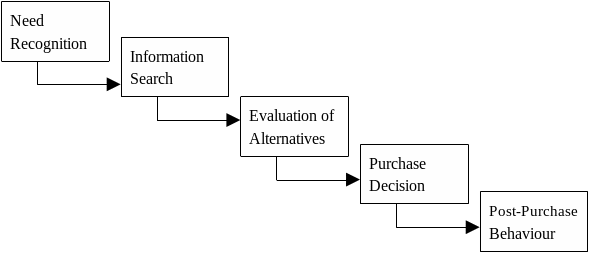
Service quality and business success
It is vital that companies must have an unmistakable picture of what the client anticipates from them. The customers’ decision on the nature of a service is altogether different from their decisions as to picking an item. This is an account that services are a great deal more unique in relation to the products. Merchandise is substantial and can be touched while services cannot be touched. A product is a perishable item but service is not.
Subsequently, these defy the clients when looking at services and items. Dissimilar to commodities or items, service cannot be touched, or tasted, or seen. The clients are known to make decisions in light of both substantial and immaterial variables. Measurements like the nature of the nourishment or administration, and the cost of the item in connection with the service are a few cases of immaterial variables that impact the business success and the decision-making the procedure of the purchasers (Lundberg 23).
The company’s proprietors typically pick to focus on unmistakable variables that are known for impacting the clients’ decision-making. The substantial measurements that they embrace are the great climate of the company, the quality and level of the service, enhanced offices, and so on (Malhotra, Marketing research: An applied orientation 126). Service shifts from one supplier to another and from a client to another.
Because of this variability, purchasers have a tough assignment to settle on choices to pick one provider over another. The company’s proprietors additionally have a tough assignment of keeping up a relentless level of operation as far as the nature of the goods or service. Case in point, if a company’s server/server gets a protestation from a client, the grumbling will impact him/her to give low-quality administrations hence.
A company’s proprietor will measure the productivity of the service strictly when he/she has sold it. Then again, a client will gauge the proficiency of the service when he/she has purchased it. The level of a polished methodology of the company workers will give the clients a knowledge concerning the service quality. In the same connection, the criticism or reactions got from clients will give the company’s proprietors an observation with respect to the clients’ fulfilment in regards to the company’s services (Vogel and Paul 128).
Clients can buy physical items at any given time because of the way that they can be put away and sold whenever the client gets some information about their accessibility. Then again, it is unrealistic to keep a service. When the customers do not buy a service, then the service does not exist in any case. Because of the way that the clients’ ways are unclear, the company’s proprietors think that it is testing to discover the harmony between the supply and demand for their services (Gibson 6).
How consumers make decisions
There are various models that describe the process of decision-making by the customers. This model gives a clarification of the strides that any customer takes subsequent to seeing the item up to the time he/she settles on the choice to buy the item. Because of the way that services fluctuate from one company to the next, the procedure by which customers settle on their choices regarding utilizing a service is far very different from the procedure by which they settle on their choices when acquiring a commodity.
There is a five-stage model of the buyer choice making procedure (Malhotra, Basic marketing research 106). The procedure begins with the need acknowledgment whereby the buyers characterize their needs. The needs can be made because of both inner and outside variables. An illustration of an inside variable is the point at which the buyer chooses to buy a product on the grounds that he/she is craving.
A sample of an outside variable is the point at which the need of the buyer is made when he sees an advert around an item. It is essential for company proprietors to be acquainted with the elements that catch the interests of the customers. These needs can be identified with a setup of a company. The mental needs of the clients will inspire them to utilize a specific product. The company’s proprietor then treats the clients with a decent quality service which gives them a feeling that they are in the right place and secure.
Likewise, clients like to pick a specific company that is in accordance with their standard; in this way, giving them a status in the general public (Neaime 241). The buyer recognizes the way that, in fact, there is a need present. The need drives the customers to discover answers. Maslow added to a progressive system of human needs. These needs were positioned by Maslow according to their hierarchy.
The next stage is the search for information. In this stage, the customer is spurred to know all the more about the service. Then the shopper assesses the accessible existing options whereby he can think about costs and quality. The shopper then settles on the choice to make the buy. The buyer will gauge their prospects about the item/benefit against the execution of the item in the post-purchase stage. The information can be pursued from companions, partners or even the press (Samuel and Douglas 55).
Sensible customers will need to have a decent learning about the service in addition to the included components before making the move to purchase it. By diving into the data about the service, an affiliation or state of mind between the buyer and the service is created. It is this affiliation/state of mind that will figure out if the customer will appreciate the service or not.
After that, the customer checks if there are other substitutes of the service. At the point when a client has recognized a need and has sufficiently assembled data about the need, he/she will search for other conceivable alternatives that exist with respect to the class of the need the client has. In this case, the client will investigate the different qualities of the need to help him/her settle on a choice (Gibson 6).
In the setting of a company, the particular traits that are investigated by the client incorporate the choices of goods offered, the costs, the essence of the service, and so on. This clarifies the essential motivation behind why one company is picked from another. The next stage is the purchase of the service. After the effective thought of the main three stages, the client will make his/her mind buy the service from the favored seller and expand it. In the setting of a company, the procedure of procurement and utilization are integral; they happen together. At this stage, the client is exceptionally certain in light of the fact that he/she has enough and significant data about the service.
The fifth stage is the assessment of the service after the consumer buys it. The company’s administrators are obliged to have as a top priority this procedure of choice making with a specific end goal to know and comprehend what the customers’ requirements are in every stage.
This will likewise help them in making valuable methods sooner rather than later (Sekaran199). The balanced buyers will need to assess if their desires have been fulfilled by the service after the purchase and utilization. At the point when the client is fulfilled, he/she is liable to settle on the company as the top decision. The client is likewise liable to end up exceptionally faithful to the company and elude a companion to the same company. In future, the client will not feel disturbed to pay more for the service on the grounds that he/she has full certainty.
The concept and theories of customer service
Consumer service is the study of how, when, why and where people do or do not source for goods or services. It attempts to assess the influence of the clients from external factors such as high salaries and income, the growth of urban lifestyle, among others. It is a common practice for the customers to purchase goods and services for a number of reasons. These reasons may include reinforcing self-concepts, maintaining a given lifestyle or becoming part of a particular group.
Consumers make their decisions based on the available time. Business chiefs are endeavoring to set up and keep up an environment that is greater for the fulfilment of consumers, who are striving together in groups towards the achievement of foreordained objectives (Sekaran 57).
A few studies have been completed to scout the examples of a quality customer service. The profiles of the consumers are differing as to their likelihood to shop at merchandising channels, their decision of shopping centers, and their sources of information concerning the accessible shopping exercises.
Consumers compete for access privileges in their environment, such as promotion and motivation increments. Consequently, integrating ethics among buyers at different levels of management plays an essential role in motivating them to put more efforts in their job roles and responsibilities. Subsequently, the business satisfaction is improved considerably. The satisfaction inequality is directly correlated to the union and individual satisfaction.
The customer service is a strategy concerning inclinations made by people or subordinate living beings among substitute types of purposeful action. The present and quick impact on the power, course and ingenuity of activity can be termed as motivation. The business administrators are aiming to build up and keep up an environment that is greater as per the general inclination of individual consumers who are inclining themselves in groups towards the accomplishment of the pre-decided objectives. The customer service can be offered to specialists according to the accompanying strategies: the standard or conventional methodology, plain dealing, human relations methodology, disguised inspiration, and rivalry (Sekaran 67).
In a related study that concentrated on hotel consumers from Britain, Germany and Japan, the consumers liked to have bundled visits; this was obvious by the critical number of the tourists in travel parties (source). At the point when the consumers travel, they generally pick tenable visit administrators who have a decent reputation. They additionally verify that their well-being will not be in any danger and that their outing will give them the fancied fulfilment. Other scholars led a survey that principally harped on the characteristics of the consumers; the study provides that the most pivotal segregating variables that existed between the individuals who travel and the individuals who don’t travel were: versatility issues, age, and level of training.
The choice of the buyers to lean toward a particular product is impacted by their demographic attributes, mental qualities, and psychographic qualities. A study led by other scholars discovered that the customers favored product bundles that offered them satisfaction and increased the value of their lives (Sekaran 57). Therefore, before the consumers settle on a choice, they generally inquire whether their desires are taken into consideration so as to have the desired satisfaction.
The latest study done by some scholars focused on the review of the past studies concerning customer service and discovered that the factors that motivate a customer can be classified into different groups, for example, craving desires, training desires, experience, blending, and breaking the monotony (source). Similarly, the outstanding push and force motivations of the consumers were the determinants of their level of satisfaction which in turn promotes the development of the business.
Businesses progressively perceive satisfaction as an element that can promote an organization’s superiority with reference to competition, rather than cost. This trend is most prevalent within the private sector. The businesses in the private sector are gradually aligning the customer service schemes with the consumer or organizational satisfaction. Consequently, the popularity of a quality customer service has increased considerably. The satisfaction derived from an effective customer service includes a system which awards workers who have worked above their normal working levels with money.
Push and pull motivation
Push motivation is likened to self-discipline; where individuals are pushing forward to accomplish a goal. This kind of motivation effortlessly prompts disheartening at whatever point obstructions are realized in the way of its accomplishment. This sort of motivation is questionable. Self-resolve alone is just as solid as the yearning behind the self-control. With push motivation, it is anything but difficult to scrutinize your unique objective when things are complicated, and you ask yourself whether this will be justified despite all the trouble.
Pull motivation is the type of motivation that is significantly more capable than push motivation. The things that an individual needs are so convincing and energizing and they appear to force the individual to them. Each consumer has encountered pull motivation at some point. Under pull motivation, the efforts are simple. The consumer needs satisfaction so bad that it just appears to draw the consumer to it. Under pull motivation, the consumer does not need persuading himself to buckle down. The things that an individual needs are so convincing and are attractive (Sekaran 67).
A customer is driven by two constraints; the first compel, known as ‘push’, steers the consumer out of his/her home determined by the wish to go to an unspecified business sector. In this connection, the inspiration of the push power relies upon the fulfilments foreseen by the consumer, the desire to enterprise, renown, learning, and the longing to make new companionships. The second compels, known as ‘pull’, furnishes the consumer with the heading in regards to the decision of the chosen business sector.
The thought processes of the pull force impact the consumer’s decision on the spot to visit; the powers are joined with the components of the destination and the foundations that characterize customer service. The components of the destination empower the buyer to make verdicts regarding their desires (Neaime 240).
The inner motivational variables stem from the push intentions while the outer motivational components stem from the force thought processes. Recognition is a vibrant process because of the way that the consumers can choose to arrange and to delineate the different stimuli into a helpful and clear way. The impression of the customer, along these lines, changes from the genuine attributes of an item to the way in which the consumer handles and investigates the data (Neaime 237).
Discernment can happen specifically if the consumer chooses to be particular in his/her presentation, consideration, perceptual blockage and perceptual resistance. It is a typical routine of the shoppers to choose just things they need and shut out the things that they see as superfluous or unfavorable to them. There are two ideas of recognition that come from the consumers’ learning procedure. One of the ideas is the intellectual observation while the other one is the enthusiastic recognition.
Customer service can be clarified as the greatness of duty, life, and innovation in the piece of the customer. For some visit supervisors, in the midst of ever slowly expanding more forceful business environment of the late years, figuring out, intends to propel the customers. A number of past studies on the impact of customer service on consumer and organizational productivity have shown that pull factors of motivation contribute to productivity gains (source). The contribution of the pull motivation schemes to the consumer and organizational satisfaction varies depending on whether the motivation is individual or collective and satisfaction-related. The returns to satisfaction, motivation are larger for ethnic minorities, particularly in the case of women.
The customer service is viewed as a state of the condition of necessities that impacts a consumer to participate in a certain activity or movement that has a higher likelihood of granting him/her a certain level of wanted fulfilment (Samuel and Douglas 58). The customer service is a technique concerning inclinations made by people among substitute types of intentional action recommended that the current and quick impact on the energy, bearing and constancy of activity can be termed as motivation. In the same way, the customer service can be offered to the consumers, according to the accompanying systems, the standard or conventional methodology, valid mechanisms, human relations methodology, disguised inspiration, and competition.
Methodology
Introduction
Research Methodology is an approach to discover the aftereffect of a given issue on a particular matter or issue that likewise alludes as a problem in research. In Methodology, analyst utilizes diverse methods for comprehending and looking at the given problem in research. Diverse sources use distinctive sort of strategies for taking care of the issue. Considering the term ‘methodology’, provides the method for seeking or taking care of the problem in research.
Noting unanswered inquiries or investigating which, as of now, does not exist, is considered to research. Research methodology is a cautious examination or requests particularly through the quest for new realities in any branch of learning (Zikmund 58).
Research philosophy
Research philosophy refers to the improvement of the research foundation, research information and its tendency. It is additionally characterized with the assistance of research paradigm. Research paradigm is the wide structure, which contains discernment, convictions, and comprehension of a few hypotheses and practices that are utilized to lead a research. It is described as an exact methodology, which includes different strides through which an analyst makes a relationship between the research targets and inquiries.
Paradigm is a particular state of mind about directing an exploration. It is not entirely a procedure, but rather all the more a logic that aides how the exploration is to be led (Wagner 200). Research philosophy and logic contains different variables, for example, the state of mind of an individual, his point of view, the assortment of convictions towards reality, and so on. This idea impacts the convictions and estimation of the scientists, with the goal that he can give substantial contentions and phrasing to give solid results.
There are three sorts of the research paradigm. They incorporate authenticity, positivism and interpretivism. All these paradigms were taken into consideration in this study. This study utilized the positivism approach because it sought to give the standpoint to evaluate the social world with the offer of objectivity set up of subjectivity.
Quantitative and Qualitative Approach
Qualitative research, commonly known as subjective research is a form of exploratory examination (Zikmund 209). We utilized this approach to pick up a comprehension of hidden reasons, sentiments, and inspirations. It provided us with bits of knowledge into the role of customer service in business success for potential quantitative examination. We additionally used this approach to reveal patterns in thought and sentiments, and plunge more profound into the issue.
The subjective information accumulation systems vary utilizing unstructured or semi-organized methods. Some regular routines incorporate focus groups, individual meetings, and cooperation or perceptions. The sample size is ordinarily little, and respondents are chosen to satisfy a given share (Zikmund 209).
We utilized the quantitative approach to evaluate the subject matter by a method for producing numerical information or information that can be changed into usable insights. We utilized the technique to evaluate states of mind, suppositions, practices, and other characterized variables – and sum up results from a bigger sample of the population. Quantitative Research utilizes quantifiable information to plan actualities and reveal designs in the examination.
Quantitative information accumulation routines are considerably more organized than the qualitative information gathering strategies. Quantitative information gathering techniques incorporate different types of overviews – online studies, paper reviews, phone interviews, longitudinal studies, site interceptors, online surveys, and orderly perceptions.
Merits and demerits of primary research
We used the primary exploration to addresses the objective issues. Primary research enabled us to have the overall control of the procedure and the exploration is shaped similarly as its destinations and degree is concerned. We had to focus our attempts to discover information with respect to particular market instead of fixation on the mass business sector. The elucidation of information is better in primary exploration. The gathered information can be analyzed and translated by the advertisers relying upon their needs as opposed to depending on the elucidation made by authorities of optional information.
Normally auxiliary information is not all that late and it may not be particular to the spot or circumstance that the advertiser is focusing on. Primary research turns into a more precise device since we can utilize information which is helpful for him. We were the proprietor of that data and we needed not impart it to different organizations and contenders. This gives an advantage over contenders answering on optional information (Zikmund 209).
Gathering information utilizing primary exploration is an expensive affair as the advertiser must be included all through and needs to outline everything. Due to comprehensive nature of the activity, the period needed to do research precisely is long when contrasted with secondary information, which can be gathered in much lesser time length. In the event that the exploration includes taking feedback, there are high risks that input given is not right. Criticisms by their essential nature are normally one-sided or given only for the purpose of it. Apart from cost and time, different assets like HR and materials too are required in a bigger amount to do studies and information accumulation (Zikmund 209).
Research Design
The research design is the output of a progression of our choices in regards to how the study will be directed. The research design is nearly connected with the system of the study and aides making arrangements for executing the study (Zikmund 209). This study relied on the explorative research design. It is an outline for directing the study that emphasizes on control over variables that could meddle with the legitimacy of the discoveries. The research designs differ as to the amount of structure the analyst forces on the examination circumstance and the amount of adaptability is permitted once the study is ongoing. Many quantitative studies have more structured research designs than qualitative studies, which have more fluid research designs.
A strategy that is regularly utilized to acquire data on social and behavioral elements and the connections between these elements is a research survey. In this case, we chose a sample or subgroup of individuals and get some information about issues identified with the examination. The responses to these inquiries are then viewed as a depiction distinguishing the suppositions and states of mind of the entire populace from which the example was taken.
Descriptive exploratory design
Many studies of a survey can adopt a descriptive research design or an exploratory research design. Depiction can be a noteworthy motivation behind both subjective and quantitative explorations. The descriptive research design enabled us to acquire data regarding any phenomenon. Exploratory studies give an inside and out an investigation of a solitary procedure. On the other hand, the descriptive research design analyses the attributes of a particular populace.
Both exploratory research design and descriptive research design start with the problem statement. Exploratory exploration goes for researching the research problem, the way in which it is showed, and alternate components with which it is connected. An exploratory research design is embraced when another zone or theme is being researched.
Case Study Approach
A contextual (or a case study) analysis includes a very close and point by point analysis of a subject (the case), and also its related logical conditions. Contextual investigations show up with incredible recurrence all through well-known works. Almost anybody with training can make a case for having done a contextual investigation sooner or later in their life. Contextual analyses additionally can be delivered by taking after a formal exploration technique.
The subsequent assortment of contextual investigation exploration has long had an unmistakable spot in numerous orders and callings, extending from science, humanities, human science, and political science to training, medical science, social administration, and managerial science. In doing contextual analysis, the ‘case’ being concentrated on may be an individual, association, occasion, or activity, existing at a particular point (Zikmund 209).
Case in point, medical science has delivered both understood contextual investigations of people and contextual analyses of medical practices. In any case, when ‘case’ is utilized as a part of a dynamic sense, as in a case, a recommendation, or a contention, such a case can be the subject of numerous exploration routines, not simply contextual analysis research (Wagner 86).
One methodology sees the contextual analysis characterized as an examination technique, an exact request that examines a problem inside of its genuine setting. Contextual analysis exploration can mean single and various contextual investigations. It can also incorporate quantitative proof and depends on different sources of confirmation. The methodology advantages from the former advancement of hypothetical suggestions. All things considered, case study investigation ought not to be mistaken for subjective exploration, as contextual investigations can be founded on any blend of quantitative and subjective information. In the meantime, the continuous trials can give a factual structure to making inductions from quantitative information (Wagner 86).
Population and Sampling
The aggregate gathering of subjects that meet an assigned arrangement of criteria is called a population. There is a refinement between the target populace and the available populace. The target populace incorporates every one of the cases about which the scientist might want to make speculations. The available populace involves every one of the cases that fit in with the assigned criteria and are open to the scientist as available literature.
The procedure of selecting a bit of the populace to reflect the whole populace is sampling (Wagner 86). Exploratory outline requires little examples that are picked through a deliberative procedure to reflect the wanted populace. In subjective exploration, people are chosen to partake in the examination in view of their direct experience of the problem statement (Wagner 86). In line with this survey, the population comprised of the employees of the organization under investigation. They were an excellent choice because their profiles fit the setting of this research, and also they had enough experience in the organization.
Not at all like quantitative examination, there is no compelling reason to haphazardly select people, on the grounds that control and speculation of discoveries are not the expectations of the study (Wagner 86). Purposive inspecting, a technique that includes the choice of persons who speak to the population of interest was, therefore, utilized in this study. This is a non-likelihood testing technique which includes the choice of specific subjects to be incorporated into the. With the end goal of this period of the study, respondents were chosen in light of the fact that they were workers of the association under study. The study had a sum of 169 members.
Despite the fact that this methodology expands the likelihood of population samples that do not represent the whole population, it gave the main method for reaching all the respondents. Since there were no official registers or records containing the names of the workers, the specialist chose to utilize snowball testing to distinguish the respondents. Purposive testing and snowball inspecting are connected and have one shared factor: the general population most suitable to interact with on the examination trip is chosen at the time they are required. Snowball testing is important in subjective examination because it is coordinated by people that are hard to distinguish (Wagner 86).
In snowball testing, the analyst gathers information on a couple of individuals from the objective populace he can find and afterward looks for data from those people that empower him to find different individuals from that populace. These inspecting strategies empower the analyst to choose particular subjects who will give the broadest data about the problem statement being concentrated.
Data Collection and Instrumentation
We used questionnaires for data collection. A total of 169 questionnaires were completed by the target respondents. The questions in the questionnaire are attached in Appendix 1. Adopting this method of administration validates the need to minimize the cost of the study. This is because of the fact that respondents are geographically separated (Wagner 86).
Questionnaire Survey
Questionnaires are pre-arranged course of actions on a request that require the respondents to record their reactions as a general rule in solidly portrayed alternatives. Questionnaires can be used to contact the respondents either through the mail or by face to face meeting. Before delineating a survey, there are three standards to pay thought on, these models, consolidate benchmarks of wording, principles of estimation, and the general set-up of the study. The rule of the substance includes the substance and purpose of the request, for instance, the pro needs to fathom the method for variables to be tapped.
On the off chance that a variable is subjective, for instance, customer support where a respondent’s conviction, perceptions, and perspectives are to be measured, the request should draw the estimations and parts of the thoughts. Also, where target variables, for instance, age and pay are tapped, a single direct question would be legitimate. The wording and vernacular are distinctive segments of the guideline of substance, for instance, the tongue of the overview should estimate the level of perception of respondents. Therefore, the choice of words should depend on upon the level of guideline of the respondents.
The rule of estimation encompasses the models to be taken over to ensure that the data accumulated is fitting to test the theories. These norms consolidate request, which includes the similarity of negative request to wind up positive issues, coding, using scales and scaling strategies, and steadfastness and authenticity. Constancy exhibits how relentless and solid the instrument taps the variable. The general set up of the study conceals the preface to respondents, the length of the survey, headings for completing and the general appearance of the study.
Data Analysis and Presentation
The collected data were entered into an excel sheet before further analysis by SPSS. Statistical techniques of analysis were utilized.
Ethical considerations
Just before the study was conducted, we first developed a proposal and submitted it for approval. The proposal entailed the overview and the aims of the study. In addition, the proposal entailed how the respondents of the research would be recruited and handled. The responses of the participants will be treated with confidentiality in order to respect and uphold the welfare and the right to privacy of the participants. Once the approval was given, we went ahead to conduct the research while adhering to the stipulated guidelines.
Conclusion
Research methodology is an arranged method to push to increase new information. In Research Methodology, the scientist dependably tries to seek the research question deliberately in a particular manner and figure out every one of the answers till conclusion. On the off chance that the examination does not work deliberately on the issue, then there is less probability to figure out the last result. For discovering or investigating the research questions, a scientist confronts parcel of issues that can be adequately determined with utilizing the right research methodology.
Findings, data analysis and interpretation
Introduction
This segment covers the examination of the information, presentation and understanding. The outcomes were dissected utilizing SPSS, ANOVA, relapse and connection examination.
Characteristics of the sample
In order to comprehend the demographic information of the participants, the distribution of gender, age, education level, income, and the number of years employed in the business are summarized in the following sections.
Gender
Table 1:Gender distribution
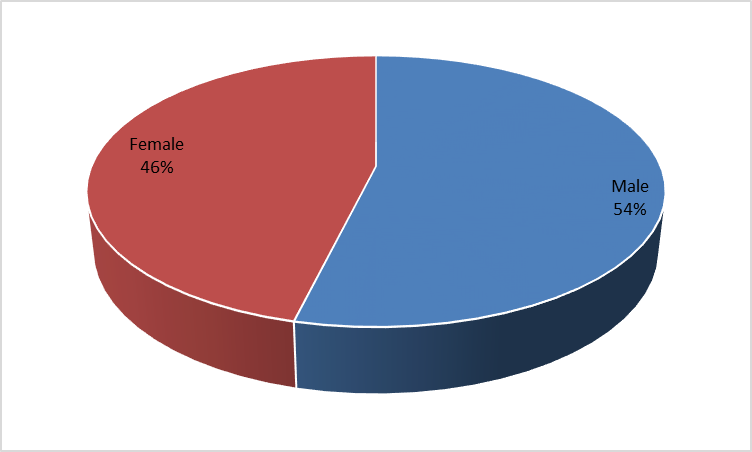
The distribution of gender is summarized in table 1 and figure 1, according to the results there are 78 females and 91 males, composed 46.2% and 53.8% of the sample respectively.
Age
Table 2: Age distribution.
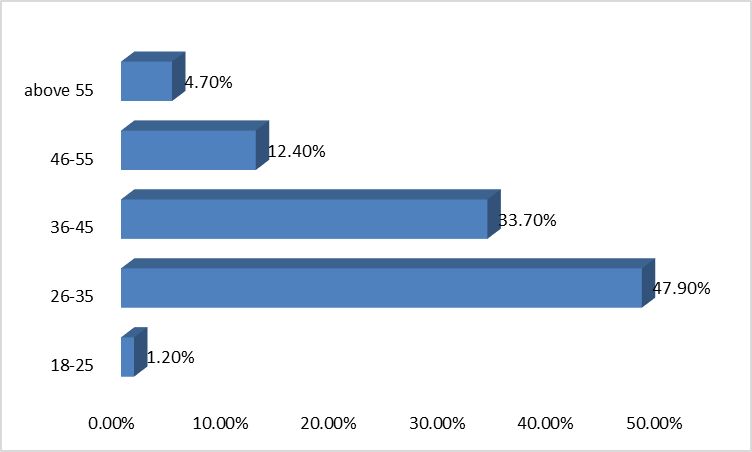
The distribution of age is summarized in table 2 and figure 2 above. According to the results, there are 47.9% of the participants aged between 26 and 35, which is the largest proportion, followed by participants aged between 36 and 45, composed 33.7% of the sample, and participants aged between 46 and 55, accounted 12.4% of the sample. Finally, participants aged above 55 or between 18 and 25 composed 4.7% and 1.2% of the sample respectively.
Education level
Table 3: Education distribution.
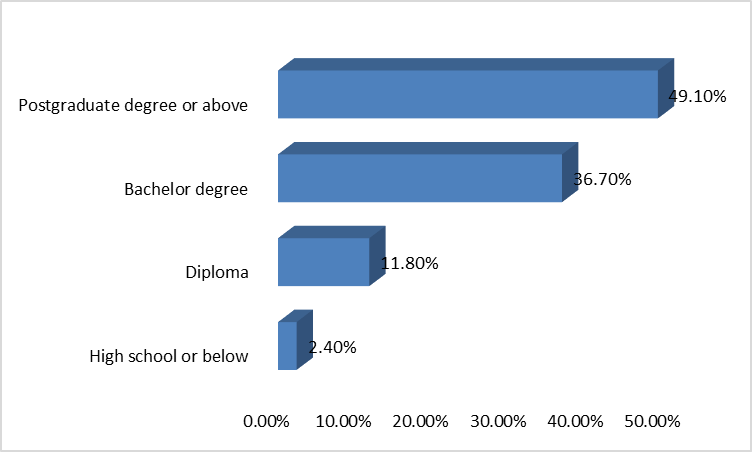
In terms of the education level, nearly half of the participants (49.1%) have a postgraduate degree or above, which is the largest proportion, followed by participants who have a bachelor degree, composed 36.7% of the sample, and participants who have a diploma, composed 11.8% of the sample. There are only 2.5% of the participants have high school or below degree.
Income
Table 4: Income distribution.
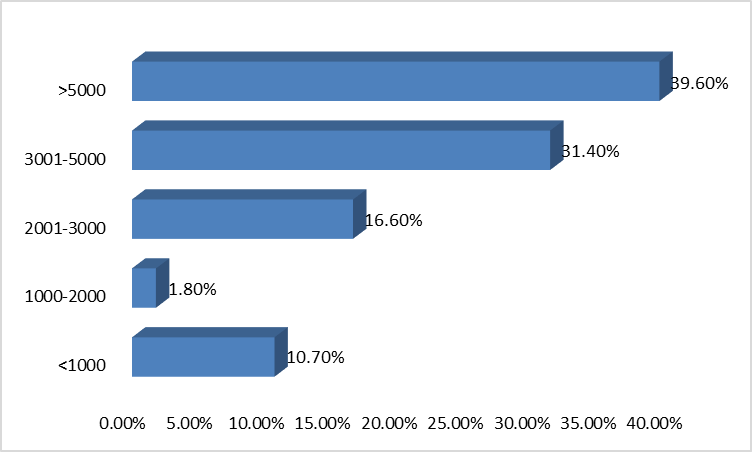
Regarding the income of the participants, 39.6% of the participants indicate that they have income above 5000, which is the largest proportion, followed by participants who have income between 3001 and 5000, composed 31.4% of the sample, and participants who have income between 2001 and 3000, composed 16.6% of the sample. There are 10.7% of the participants have income below 1000 and 1.8% of the participants have income between 1000 and 2000.
Number of years employed
Table 5: Number of years employed.
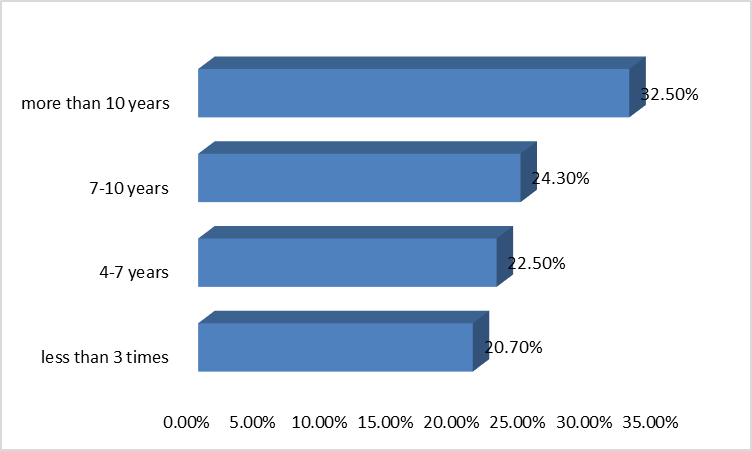
Table 5 and figure 5 above summarized the number of years that the participants have been employed. According to the results, 32.5% of the participants have stayed more than 10 years, which is the largest proportion, followed by participants who have stayed between 7 and 10 years, composed 24.3% of the sample, and participants who have stayed between 4 and 7 years, composed 22.5% of the sample. In addition, there are 35 participants have stayed in employment for less than 3 years, composed 20.7% of the sample.
Reliability Analysis
Reliability analysis is often used to evaluate whether the multiple instrument items are measuring the same variable or concept. In SPSS, the Cronbach’s Alpha value is normally used to measure the reliability of the various variables. The minimum requirement for the value of Cronbach’s Alpha is 0.7 to ensure that the items are internally consistent and reliable. In an exploratory study, the Cronbach’s Alpha value of 0.6 can also be accepted. In this study, the various measurement items are adopted from previous studies, thus, the minimum value is set as 0.7.
The corrected-item total correlation (CITC) is also included to evaluate the reliability of the individual item. If the CICT is below 0.5, then the item cannot reliably measure the corresponding variable and should be excluded from further analysis (Hair et al. 2006). The Cronbach’s Alpha if item deleted indicate whether the Cronbach’s Alpha value is decreased or increased after excluded this item. Thus, if this value is above the Cronbach’ Alpha value for the variable, the item should then be excluded from further analysis. The Cronbach’s Alpha for variables is summarized in table 6 below.
Table 6 Reliability Analysis for Variables.
According to the results, the Cronbach’s alpha value for knowledge of customer service, external factors, customer motivation, customer service quality, customer satisfaction, business facilities, and business success are 0.836, 0.817, 0.761, 0.739, 0.898, 0.833, and 0.837, which are all above the minimum requirement of 0.7. In addition, the CICT for individual items are all above the minimum requirement of 0.5 and the Cronbach’s Alpha if deleted for individual items are all below the Cronbach’s Alpha value. These results demonstrate that these items are internally consistent and reliable, and can be used for further analysis.
Frequency analysis
Frequency analysis explores the level of occurrence of the variables under investigations. The level of interactions of the variable determine the independent variable/
Knowledge of customer service frequency analysis
This frequency analysis explores on the respondents’ level of knowledge customer service.
Table 7 Knowledge of customer service frequency analysis.
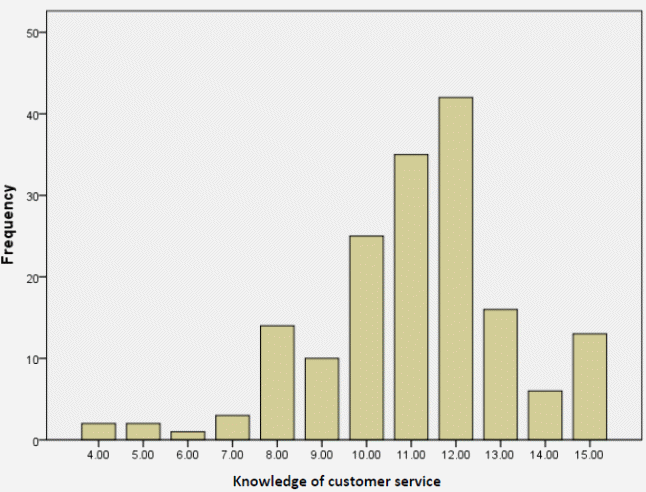
As can be seen from table 7 and figure 7, more than half of the participants are familiar with the knowledge of customer service. There are 52.1% of the participants indicate that “Compared to my colleagues, I am familiar with the customer service policies” and 46.2% of the participants indicate that “Compared to my colleagues, I know more about customer service”. From the total score of these 3 items measuring knowledge of customer service, a large group of participants have a score of 11 or 12. To gain a clearer picture of the participants’ knowledge of customer service, the items measuring knowledge of customer service were aggregated. The aggregated mean value was 3.69, suggesting that participants have medium level knowledge of the customer service policies.
External factors frequency analysis
This frequency analysis explores on the respondents’ level of knowledge of the external factors affecting customer service.
Table 8 External factors frequency analysis.
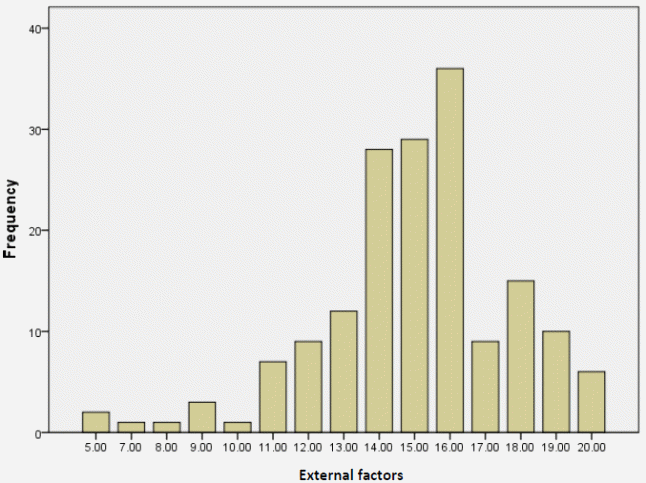
Table 8 shows the overall responses to the external factors among participants. According to the results, the mean value for all measurement items was between 3 and 4. Thus, the participants’ attitude concern was at a medium level. By analyzing the frequency, it can be seen that more than half of the participants have expressed their concern regarding the environmental problem.
In order to gain a more detailed picture of the level of external factors, the aggregate mean score was classified into three levels: low (below 2), medium (2-4), and high (4-5). The aggregate mean score was 3.76, suggesting a medium level of external factors. The overall scores from the items measuring external factors were summarized, and it is found that the range was 16, with scores ranging from 5 to 20. The majority of the participants have an overall score between 14 and 16.
Customer motivation frequency analysis
This frequency analysis explores on the respondents’ level of the customer motivation strategies.
Table 9 Customer motivation frequency analysis.
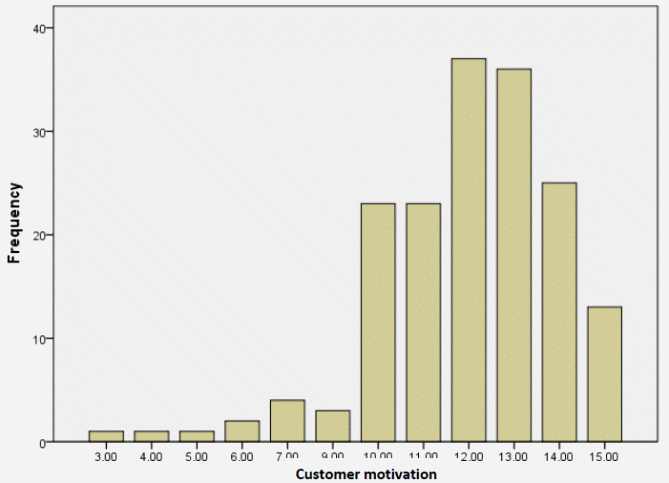
Table 9 summarized the frequency analysis for items measuring customer motivation. According to the results, a majority of the participants agree or strongly agree that “Our business offers excellent customer service”, “Our services and products are acceptable”, and “Compared to the other businesses, our organization offers the best customer service”. The aggregated mean value of customer motivation is 3.98, nearly 4, suggesting that participants have a positive attitude towards the customer motivation factors of the business. Figure 9 summarized the score of the items measuring customer motivation. As can be seen from the results, the majority of the score ranged between 10 and 15, indicating a relatively higher level positive attitude towards customer motivation.
Customer service quality frequency analysis
This frequency analysis explores on the respondents’ level of the customer service quality.
Table 10 Customer service quality frequency analysis.
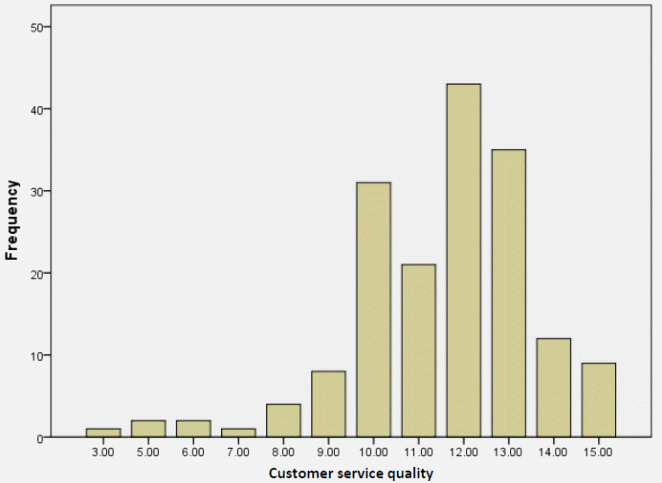
Table 10 summarized the frequency analysis for items measuring customer service quality. According to the results, more than half of the participants agree or strongly agree that “The employees are reliable and helpful”, “The employees are professional”, and “The employees respond to the customers’ inquiries quickly”. The aggregated mean value of customer motivation is 3.85, suggesting that customer service quality is at medium to high level. Figure 10 summarized the score of the items measuring customer service quality. As can be seen from the results, the majority of the score ranged between 10 and 13, which also indicate a medium to high-level customer service quality perception.
Customer satisfaction frequency analysis
This frequency analysis explores on the respondents’ level of the customer satisfaction.
Table 11 Customer satisfaction frequency analysis.
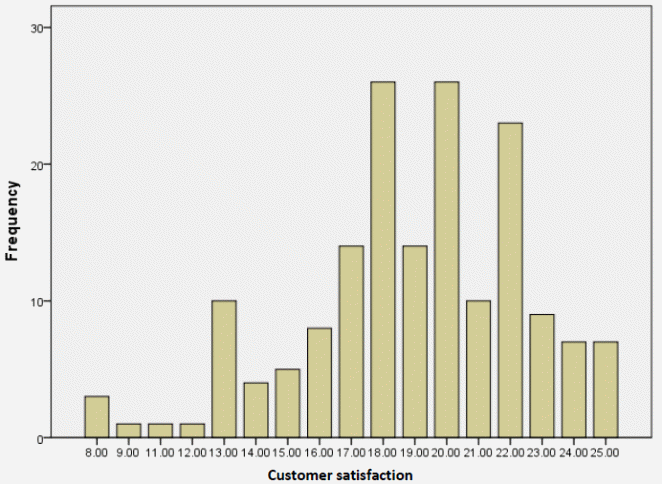
Table 11 summarized the frequency analysis for items measuring customer satisfaction. According to the results, more than half of the participants agree or strongly agree that “The business environment is comfortable”, “The business environment is appealing”, “The business environment is clean”, “The business products are appropriate”, “The business operations are appropriate”. The aggregated mean value of customer motivation is 3.79, suggesting that customer satisfaction is at medium to high level. Figure 11 summarized the score of the items measuring hotel facility. As can be seen from the results, the majority of the score ranged between 18 and 22, which also indicate a medium to high-level hotel facility perception.
Business facilities frequency analysis
This frequency analysis explores on the respondents’ level of the business facilities.
Table 12 Business facilities frequency analysis.
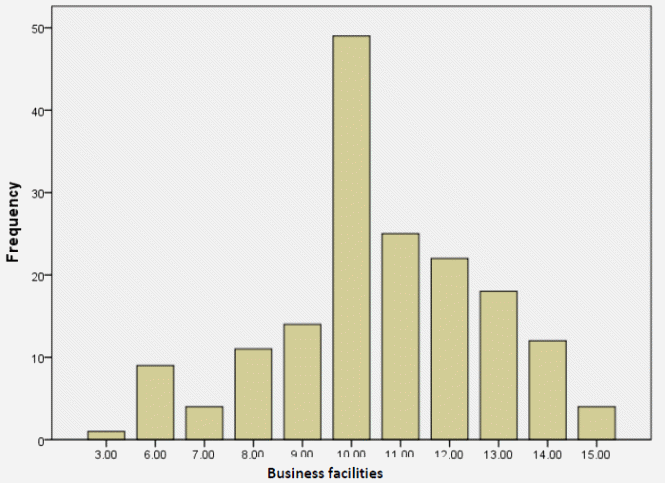
Table 12 summarized the frequency analysis for items measuring business facilities. According to the results, less than half of the participants agree or strongly agree that “The business facilities are comfortable”, “The business facilities are appealing”, “The business facilities are appropriate”. The aggregated mean value of customer motivation is 3.53, suggesting that the business facilities is at a medium level. Figure 12 summarized the score of the items measuring business facilities. As can be seen from the results, the majority of the score ranged between 10 and 11, which also indicate a medium level business facilities perception.
Business success frequency analysis
This frequency analysis explores on the respondents’ level of the business success.
Table 13 Business success frequency analysis.
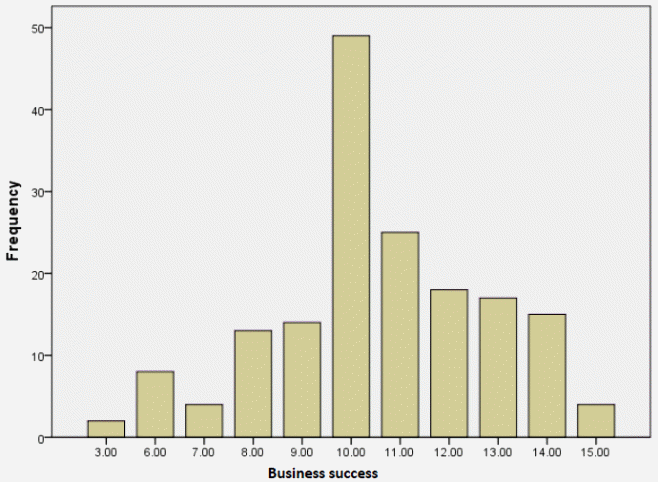
Table 13 summarized the frequency analysis for items measuring business success. According to the results, nearly half of the participants agree or strongly agree that “Good customer service promotes customer loyalty”, “Good customer service improves the customers’ experience”. The aggregated mean value of customer motivation is 3.52, suggesting that the business facilities is at a medium level. Figure 13 summarized the score of the items measuring business success. As can be seen from the results, the majority of the score ranged between 10 and 11, which also indicate a medium level business success.
Correlation analysis
Correlation analysis is the exploration of the interaction among the independent variables that explain the dependent variable.
Correlation between the knowledge of customer service and Business success
In order to check the correlation between knowledge of customer service and business success, a scatterplot was first created in order to ensure that there was not a violation of the assumptions of normality, linearity and homoscedasticity among the data. As seen in Figure 14 below, there is a strong, positive correlation between the variables of knowledge of customer service and business success and the data is normally distributed.
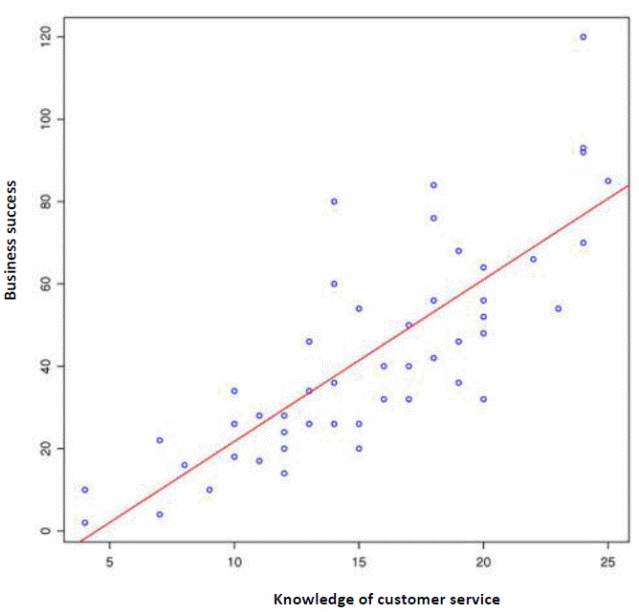
After getting a positive correlation between knowledge of customer service and business success, a Pearson product-moment correlation coefficient was carried out to analyze the relationship between knowledge of customer service and business success. The results are shown in table 14 below. The correlation value below 0.3 indicates low-level correlation; the correlation value between 0.3 and 0.6 indicates a medium level correlation, while the correlation value above 0.6 indicates high-level correlation. As can be seen in Table 14, there was a medium positive correlation between knowledge of customer service and business success, with a correlation value of 0.373, which is significant at 0.01 level, indicating that higher levels of knowledge of customer service are associated with higher levels of business success.
Table 14 Correlation between knowledge of customer service and business success.
Correlation between external factors and Business success
In order to check the correlation between knowledge of customer service and business success, a scatterplot was created. As seen in Figure 15 below, there is a strong, positive correlation between the variables of external factors and business success and the data is normally distributed.
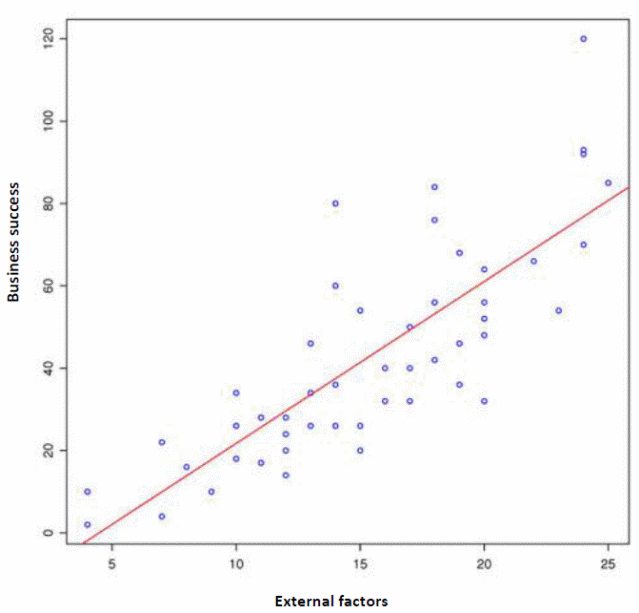
After getting a positive correlation between external factors and business success, a Pearson product-moment correlation coefficient was carried out to analyze the relationship between external factors and business success. The results are shown in table 15 below. As can be seen in Table 15, there was a medium positive correlation between external factors and business success, with a correlation value of 0.313, which is significant at 0.01 levels, indicating that higher levels of external factors are associated with higher levels of business success.
Table 15 Correlation between external factors and business success.
Correlation between customer motivation and business success
In order to check the correlation between customer motivation and business success, a scatterplot was created. As seen in Figure 16 below, there is a strong, positive correlation between the variables of customer motivation and business success and the data is normally distributed.
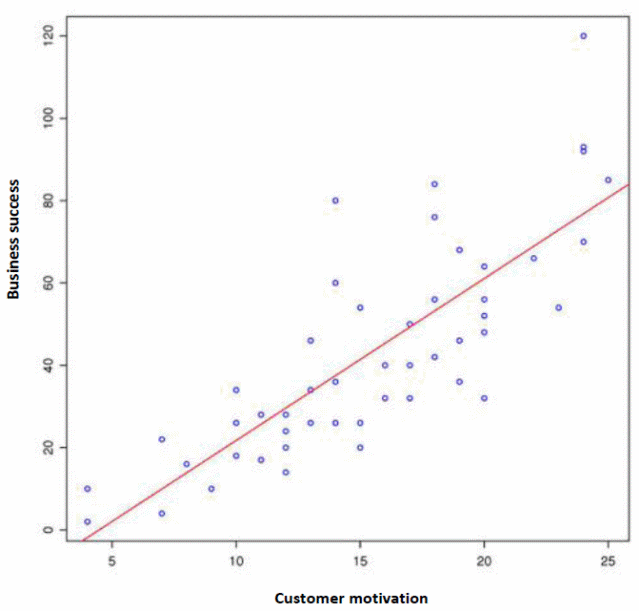
After getting a positive correlation between customer motivation and business success, a Pearson product-moment correlation coefficient was carried out to analyze the relationship between customer motivation and business success. The results are shown in table 16 below. As can be seen from this table, there was a medium positive correlation between customer motivation and business success, with correlation value of 0.412, which is significant at 0.01 levels, indicating that higher levels of customer motivation are associated with higher levels of business success.
Table 16 Correlation between customer motivation and business success.
Correlation between customer service quality and business success
In order to check the correlation between customer service quality and business success, a scatterplot was created. As seen in Figure 17 below, there is a strong, positive correlation between the variables of customer service quality and business success and the data is normally distributed.
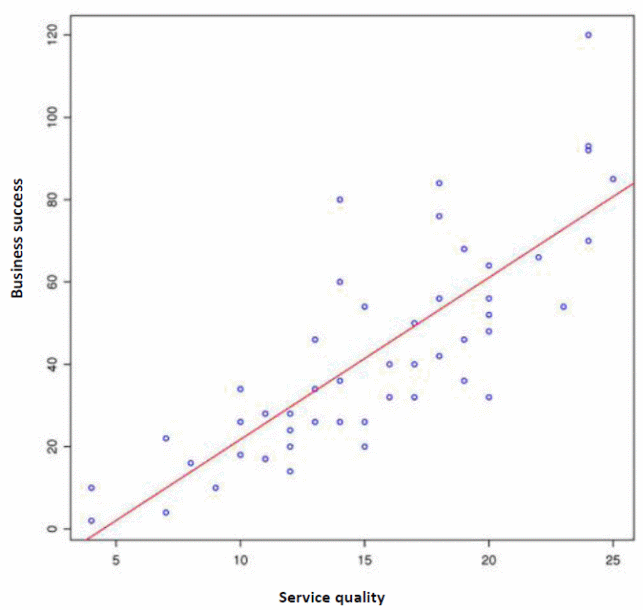
After getting a positive correlation between customers service quality and business success, a Pearson product-moment correlation coefficient was carried out to analyze the relationship between customer service quality and business success. The results are shown in table 17 below. As can be seen from this table, there was a medium positive correlation between customer service quality and business success, with a correlation value of 0.409, which is significant at 0.01 level, indicating that higher levels of customer service quality are associated with higher levels of business success.
Table 17 Correlation between customer service quality and business success.
Correlation between customer satisfaction and business success
In order to check the correlation between customer satisfaction and business success, a scatterplot was created. As seen in Figure 18 below, there is a strong, positive correlation between the variables of customer satisfaction and business success and the data is normally distributed.
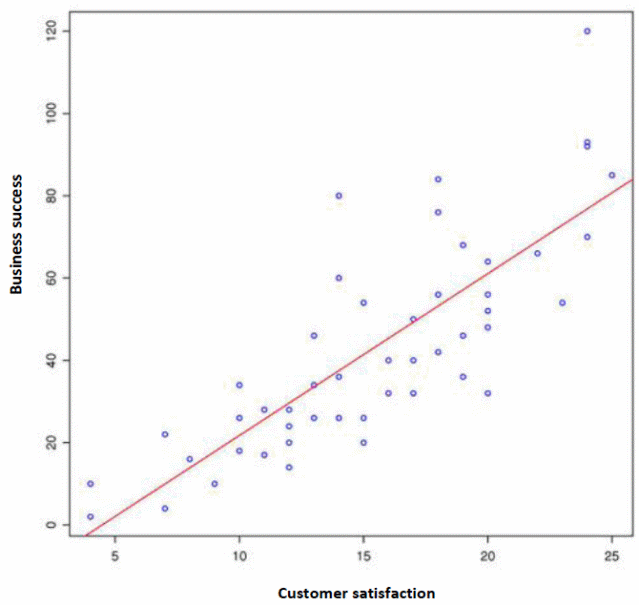
After inspected a positive correlation between customer satisfaction and business success, a Pearson product-moment correlation coefficient was carried out to analyze the relationship between customer satisfaction and business success. The results are shown in table 18 below. As can be seen from this table, there was a medium positive correlation between customer satisfaction and business success, with a correlation value of 0.455, which is significant at 0.01 levels, indicating that higher levels of customer satisfaction are associated with higher levels of business success.
Table 18 Correlation between customer satisfaction and business success.
Correlation between business facilities and business success
In order to check the correlation between business facilities and business success, a scatterplot was created. As seen in Figure 19 below, there is a strong, positive correlation between the variables of business facilities and business success and the data is normally distributed.
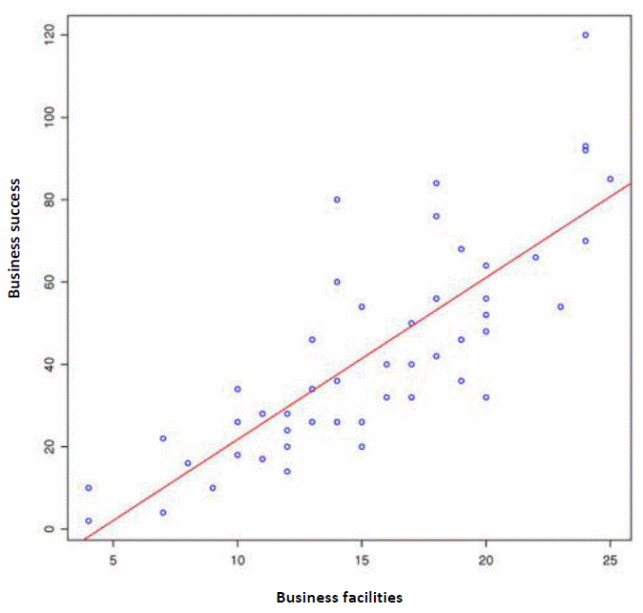
After getting a positive correlation between business facilities and business success, a Pearson product-moment correlation coefficient was carried out to analyze the relationship between business facilities and business success. The results are shown in table 19 below. As can be seen from this table, there was a strong positive correlation between business facilities and business success, with a correlation value of 0.765, which is significant at 0.01 levels, indicating that higher levels of business facilities are associated with higher levels of business success.
Table 19 Correlation between business facilities and business success.
Regression analysis
Regression analysis is a statistical process for estimating the relationships among variables (Wagner, 2009). More specifically, regression analysis is normally used to understand how the change of independent variable can affect the change of dependent variables. The correlation analysis above indicated that there are relationships between business facilities, customer satisfaction, knowledge of customer service, customer motivation, customer service quality, external factors and business success. In order to find out how these variables influence customer business success and which one has the biggest impact, the multiple linear regression analysis is used.
Table 20: Model Summary.
The Adjusted R Square is 0.536, which means that the independent variables of business facilities, customer satisfaction, knowledge of customer service, customer motivation, customer service quality, and external factors can explain 53.6% of the variance of business success.
Table 21: ANOVA.
By summarizing the ANOVA table, it can be said that the independent variables of business facilities, customer satisfaction, knowledge of customer service, customer motivation, customer service quality, and external factors can predict the dependent variable of business success at a significance of 0.01, by considering F=411.961.
Table 22: Coefficients.
The regression results are summarized in table 22 above. According to the results, the independent variables cannot predict each other as the variance inflator factor values for all independent variables are less than 10 and the Tolerance value for all variables are above 0.1. It is found that business facilities, customer satisfaction, knowledge of customer service, customer motivation, customer service quality, and external factors can significantly impact business success, with sig values all less than 0.05.
Specifically, business facilities has the biggest impact on business success, with a standardized coefficient value of 0.437, followed by customer satisfaction, with a standardized coefficient value of 0.424 and customer motivation, with a value of 0.334. The external factors have the smallest impact on business success, with a standardized coefficient value of 0.212.
Conclusion and recommendations
Introduction
This part demonstrates the outline of the revelations and examination of the results in comprehension to the objectives of this study. Finally, the segment contains the conclusions and recommendations.
Conclusion
The client service might be considered as the process of satisfying the customer, with respect to the product or service in the way the client characterizes his or her need and having that service conveyed with viability, empathy, and affectability. Pricing of goods and services is a major determinant of customers’ response towards their purchase or consumption. Some retailers insist on price consistency across channels, but successful multichannel players such as Walmart, Tesco, and AT&T differentiate their prices across online and offline channels” to provide unique services to their customers. Companies use price differentiation strategies to appeal to different customer segments that show dissimilar willingness to pay.
Customers pay prices that correspond to their maximum willingness to pay, and in this case, the profitability of the seller increases because of higher revenues, ideally without associated costs to implement the price differentiation. Notably, price differentiation can maximize the profitability of a firm in the markets where customer tastes are diverse, and inter-consumer arbitrage is hard. Thus, this paper hypothesizes that the price differentiation has a positive impact on the business success.
Consumer motivation is viewed as a state of the condition of necessities that impact a man to participate in a certain activity or movement that has a higher likelihood of conceding him/her a certain level of wanted fulfilment. The profit and non-profit oriented organizations are increasingly being concerned with the consumer motivation to improve their satisfaction. Consumer behavior arises from the fact that customers have expectations on satisfaction levels and job positions.
If they perceive that they are unfairly satisfied or paid, they are likely to reduce their effort in chasing after the product. Moreover, the development of the perception of being under-satisfied is likely to contribute to the negative demeanor amongst users. Examples of such behaviors include sabotage, lack of cooperation and cohesion amongst clients.
This aspect might significantly reduce the overall organizational satisfaction. Motivating the shoppers’ higher satisfactions improve a business’s competitiveness in the market, hence improving the likelihood of attracting and maintaining more. High satisfaction acts as an incentive in promoting consumer loyalty. High levels of satisfaction are positively correlated with the loyalty and positive bearings of the clients. This strategy is mainly prevalent in societies that have adopted individual satisfaction-related motivation systems. Under such circumstances, clients understand the apparent consequences that are associated with poor satisfaction.
Other scholars bring into the center the use of a macroeconomic hypothesis to the subject of tourism. Macroeconomics examination makes a stage that is useful for the investigation of the conduct of the consumers. The entire choice making procedure of the customers is investigated by the professional models. The models give careful consideration to the hidden components that impact the choice making procedure of the consumers. In straightforward terms, professional models give out data that identify with the conduct of the consumer in their choice making procedure. The thought that the consumers endeavor to amplify the utility that they get from tourism adds to the procedure of tourism investigation.
Mainly, many customers prefer to use or purchase products and services from firms that provide timely services. Notably, individuals who work with busy schedules will choose to travel on flights that reach their destination on time in spite of the charges. Customers feel more Indebted to firms that respond quickly to their needs, manage their complaints efficiently and replace or repair faulty products promptly.
In this regard, customer satisfaction is achieved through the timely provision of desirable services and at the same time, a prompt address on emerging complaints. Appropriate provision of products and services creates satisfaction to customers who in turn become prescribers through a generation of positive attitudes to the company. Overall, positive attitudes from customers enhance brand reputation and image; hence, they assist in attracting new customers. Thus, this proposal hypothesizes that reliable timely service provision has a positive impact on business success.
Recommendations
This study provides information that is adequate for the business to improve and maintain their customers. Moreover, the ease of accessibility to the business sectors should be improved so as to give an easy time for the customers. Business facilities and other customer motivation amenities should be upgraded so that they can be up to standard and fit the specifications and the requirements of the customers.
Consumers make their decisions based on the available time. The business operators are striving to set up and keep up an environment that is greater for the fulfilment of consumers, who are making effort towards the achievement of their desires. A few studies have been completed to scout the examples of the conduct of the consumers. The profiles of the consumers are differing as to their likelihood to shop at a specific shop.
Works Cited
Angel, Villarejo and Manuel Sanchez. “The impact of marketing communication and price promotion on brand equity”. Brand Management 12:6 (2005): 431-444. Print.
Barney, Jay. “Firm Resources and Sustained Competitive Advantage.” Journal of Management 17:1 (1991): 99-120. Print.
Burns, Alvin and RF. Bush. Marketing research, New Jersey: Pearson Education, 2006. Print.
Chaudhuri, Arjun and Morris Holbrook. “The chain of effects from brand trust and brand affect to brand performance: The role of brand loyalty”. Journal of Marketing 65:2 (2001): 81-93. Print.
Cooper, Donald and PS. Schindler. Business research methods, New York: McGraw Hill, 2006. Print.
Gibson, Pattie. The World of Customer Service, Mason, OH: South-Western Cengage Learning, 2011. Print.
Haley, James. “Economic Dynamics of Work.” Strategic Management Journal 7.1 (2006): 459-471. Print.
Haspeslagh, Philippe, and DB. Jemison. Managing Acquisitions: Creating Value through Corporate Renewal, New York: Free Press, 2011. Print.
Jackson, Robert. “A lighter wallet due to loyalty: the influence of brand loyalty on the amount a consumer is willing to pay for their preferred brand”. Journal of Psychology 1:1 (2010): 12-15. Print.
Kent, Ray. Marketing Research, London, England: Thomson Learning, 2007. Print.
Kotler, Philip. Marketing insights from A to Z, Melbourne, Canada: John Wiley and Sons, 2003. Print.
Lundberg, Curt. “Toward Theory More Relevant for Practice.” Current Topics in Management 6.1 (2001): 15-24. Print.
Malhotra, Naresh. Basic marketing research, New York, Pearcon Education, 2005. Print.
Malhotra, Naresh. Marketing research: An applied orientation, New York, Pearson Education, 2004. Print.
Neaime, Simon. “Financial Market Integration and Macroeconomic Volatility in the MENA Region: an Empirical Investigation.” Review of Middle East Economics and Finance. 3.1 (2005): 231-253. Web.
Samuel, Craig, and PS. Douglas. International Marketing Research, London, England: John Wiley, 2005. Print.
Sekaran, Uma. Research methods for business: A skill building approach, New York, John Wiley and Sons, 2003. Print.
Vogel, Julia, and Michael Paul. “One firm, One Product, Two Prices: Channel-Based Price Differentiation and Customer Retention.” Journal of Retailing and Consumer Services 27.1 (2015): 126-139. Print.
Wagner, William. Using SPSS for social statistics and research methods, London, UK: SAGE Publications Ltd, 2009. Print.
Zikmund, William. Business research methods, New York, Thomson South Western, 2003. Print.
